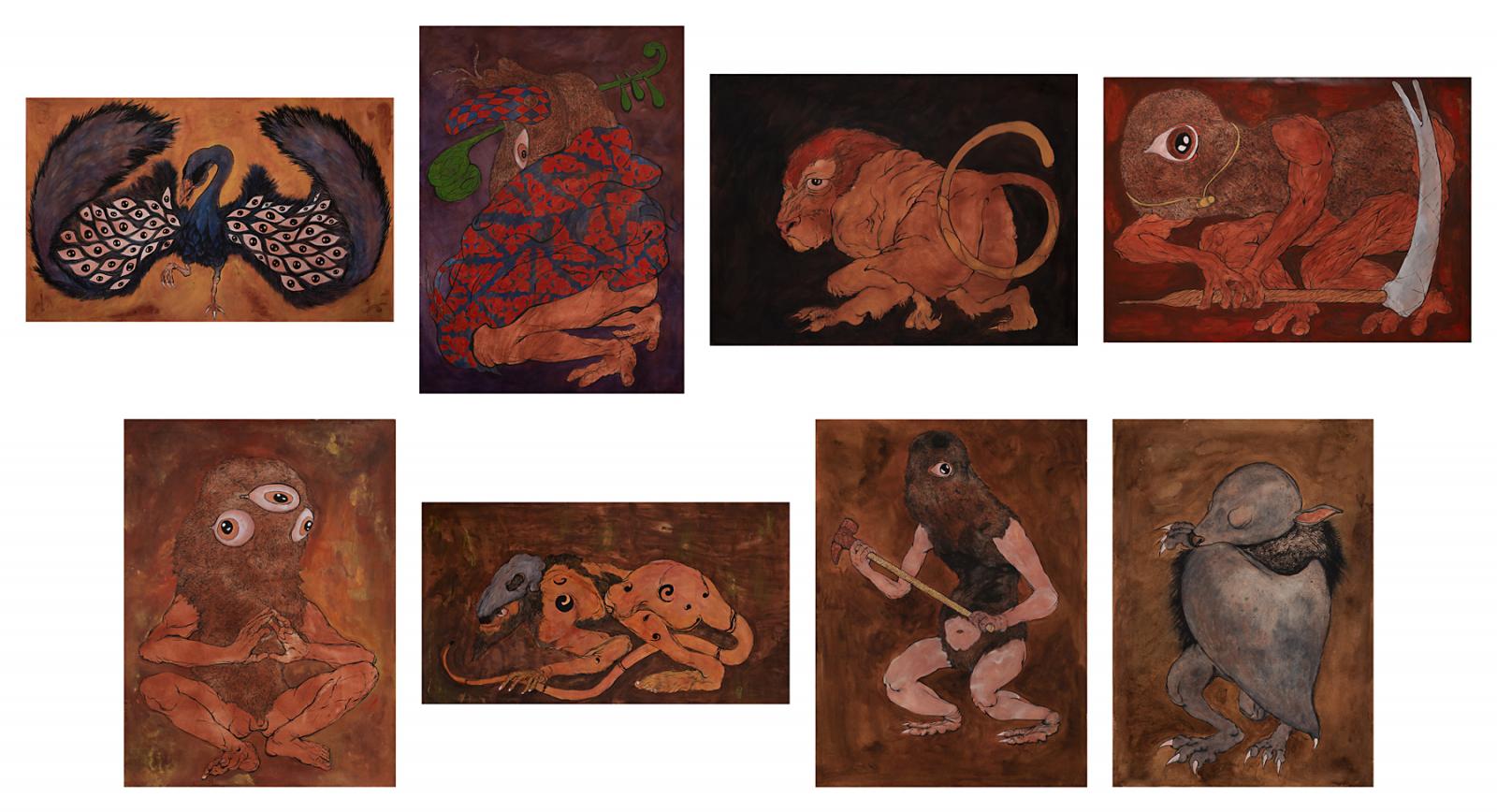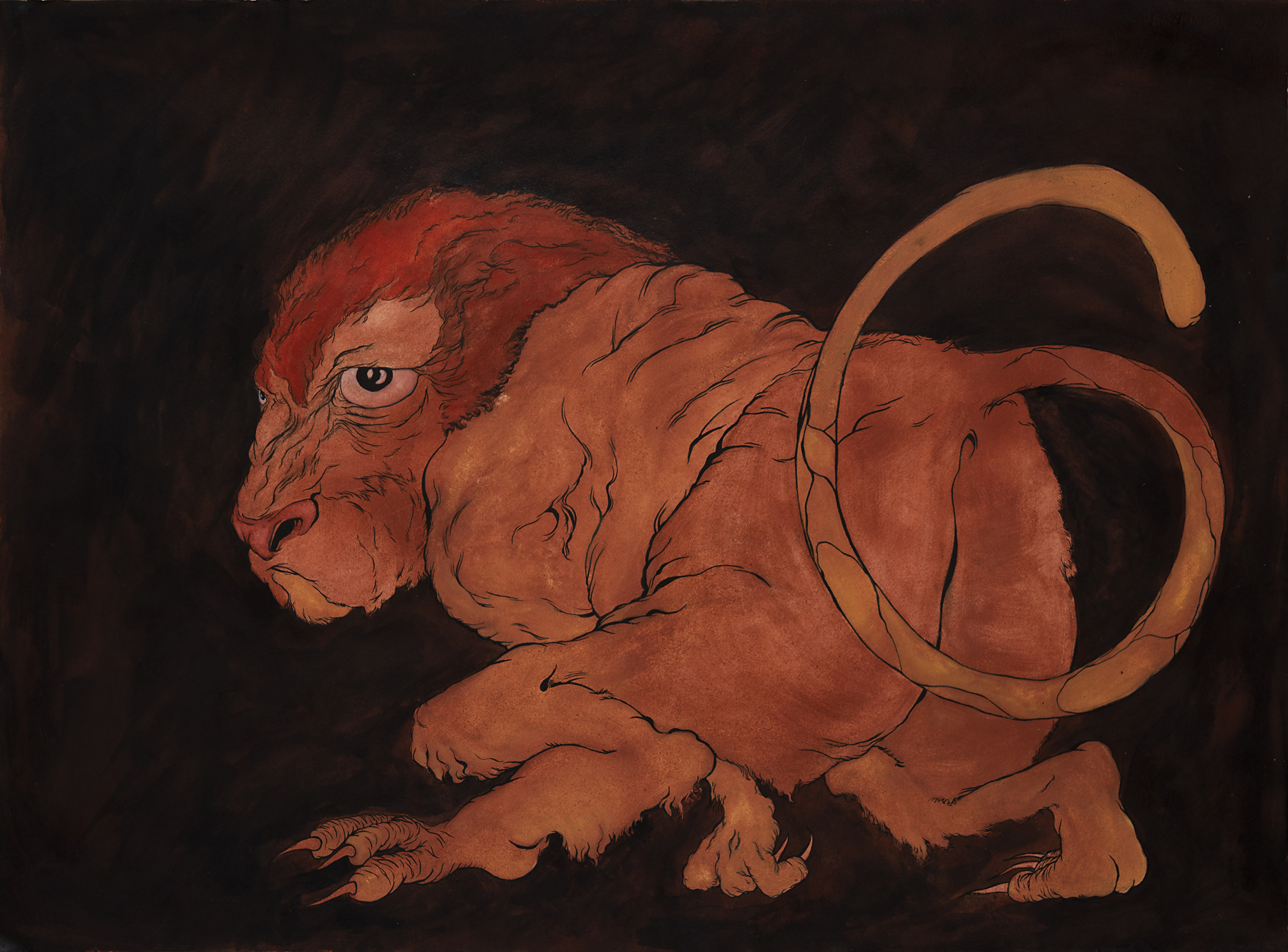Artist statement
My paintings are pages of a fragmented, quasi-historical manuscript that functions as an absurd encyclopedia of a fictional civilisation. The pages of this encyclopedia grow in the manner of Borges’s The Book of Sand, with each page of the manuscript iteratively cataloguing the creatures that roam the civilisation, charting their origins, customs, rituals, and myths.

Sahej Rahal
born 1988
Antraal
My work can be seen as a form of world-building, where the artefacts of a fictional universe are populated by strange beings and their absurd tools and totems, slipping through the cracks into our world, refashioning everyday detritus to take its own physical form. It can be seen as “speculative metafiction,” where the imagined contends with the real. Consequentially the objects of this fictional world become “vessels of narrative potential” that weave together performances, fictitious ethnographic documentaries, and sculptural installations.
Now, I have a proposition to ask of this unfolding narrative structure. What if one day, these “vessels of narrative potential” became active participants in the shaping of this world, beyond the form I give them? Or more crudely put, what if these objects could begin to think?
This brings us to the strange world of video games.
Recently I created a game called Juggernaut. The game allows a player to control an organic blob-like form in a stark desert littered with the debris of some long-forgotten architecture. As players move through the space, they can collect parts of this debris by attaching it to the blob, creating sculptural forms similar to my “walker” sculptures.
Nowadays, most video games are populated by AI-controlled objects called non-playable characters (NPCs). NPCs appear as dragons, goblins, or giant killer robots in most games, posing obstacles to overcome by reacting to the behaviour of the players in the game.
As I studied the manner in which these NPCs are programmed, I started to see a complex network of interlinked behavioural commands that direct the NPCs to move around in the game world. These commands range from controlling simple movements to more complex actions like chasing or attacking the player. Once all these commands are combined, the NPCs get a distinct personality, allowing them to think and react to a player’s actions in unpredictable ways. A stealthy player may make the NPCs react cautiously, while an aggressive one would have to face more aggression. This helps heighten the sense of immersion of a player within the game world, depending on their style of play.
It was here that I was struck with a strange thought. What would happen if these NPCs were brought to the forefront of the game world, setting them free from the task of reacting to the inputs/movements/style of a player? What are the narratives that they would be capable of sharing, once they are active catalysts and participants in the unravelling of a story?
With this, I decided to create Juggernaut, and after a few messy rounds of programming, created an AI program for Juggernaut, or “Juggy,” as I named it while writing the code. Each time the program is run, the AI-driven Juggy perceives virtual space, choosing the objects it would pick up, and then learning to use the pieces it picked up as limbs, overcoming various restrictions to its movement.
If Juggernaut is allowed to run for an extended period of time, it produces unforeseeable sculptural forms, creating new forms each time the simulation runs.
The cascading series of actions come confoundingly close to apperception, a peculiar term coined by the philosopher René Descartes in his “Passions of the Soul.” Stemming from its Latin root, percipere, meaning “to perceive, secure, learn, or feel,” it was later expanded upon by Immanuel Kant into two categories of empirical and transcendental apperception. Kant described the former as self-consciousness along with its changing states, and the latter as a unified consciousness, a necessary condition for all experiences. Apperception became one of the founding pillars for humanist thought.
Philosopher Dagobert D. Runes further popularised the usage of apperception in modern psychology as “the process by which new experience is assimilated to and transformed by the residuum of past experience of an individual to form a new whole,” in his Dictionary of Philosophy (1942).
Through its strange movement and actions in the game world, the AI-driven Juggernaut becomes capable of performing an apperception towards the fictional landscape that it finds itself in, and also capable of a creative impulse within this environment. Now, while these two forms of being find themselves firmly situated within the human paradigm, our magenta-tentacled friend is anything but human.
In his two-part essay “The Labor of the Inhuman,” philosopher Reza Negarestani writes:
“Inhumanism is the extended practical elaboration of humanism; it is born out of a diligent commitment to the project of enlightened humanism. As a universal wave that erases the self-portrait of man drawn in sand, inhumanism is a vector of revision. It relentlessly revises what it means to be human by removing its supposed evident characteristics and preserving certain invariances. At the same time, inhumanism registers itself as a demand for construction, to define what it means to be human by treating human as a constructible hypothesis, a space of navigation and intervention.”
Let us consider Negarestani’s proposition from the vantage of Juggernaut.
Within the simulation, the Juggy AI finds itself plopped into a desert landscape littered with three-dimensional models of pillars, and scurries towards them, awkwardly bumping into the violet mountainsides that block its path. With each bump, it reassesses its path, turns around, and makes another attempt, all the while learning not only the shape of the world it finds itself in, but also becoming aware of the extent of its own faculties.
When Juggy finally lands upon a pillar, the pillar clings to it, posing an impediment in its movement, and essentially forcing it to throw away all the learning that happened until that point and revise. Soon we see Juggy learning to use the pillars that cling to it as limbs, and use them to prop itself up. With time, it learns to scale the violet cliffs that first got in its way.
Each time the program is reset, Juggy takes a different path, picking up new limbs, and constructing itself into new forms that are specific to each simulated “incarnation.” However, Juggy is able to “live” out these incarnations, beyond the basic movement functions in its code, and in doing so, emulates a version of Negarestani’s Inhumanism, firstly in its own cycle of learning and unlearning as it totters about the digital desert.
Second, and more confoundingly, it procedurally creates new sculptural forms upon itself with a chaotic creative drive that is alien to the systems that govern it. The AI-driven Juggernaut becomes “sentient” at the speculative boundaries of sentience, where the self and the construct begin to entangle.
Artist bio
Sahej Rahal works and lives in Mumbai, India. He completed his BFA in 2011 at the Rachana Sansad Academy of Fine Arts and Craft. Through his cross-disciplinary artworks that include painting, sculpture, performance, and moving images, he has developed an elaborate personal mythology of imagined characters and creatures. In 2016, he spent three weeks in residence at the Spencer Museum as part of the exhibition Temporal Turn: Art & Speculation in Contemporary Asia. During his residency Rahal used locally sourced materials to create Children of Days, a large sculptural installation in front of the Museum, and also did a performance as one of his imagined characters. Recently, he has returned to painting and begun experimenting with artificial intelligence simulations in video games, both of which further expand his large personal cosmos of imagined creatures.

